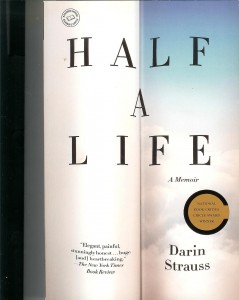I didn’t even think it was a memoir at first. The copy of Half a Life I plucked from my library shelf was a tiny maroon hardcover with only half a dust jacket. It looked kind of like a poetry collection.
In a sense, I could have judged it from its cover, because Half a Life is as much poetry as memoir, for me; it’s that rare piece of serious nonfiction where the writing, not the subject, is the star. It didn’t surprise me to learn that Darin Strauss is primarily a literary novelist. Just take this paragraph, which appears all by itself against a blank facing page—one would be forgiven for thinking it a prose poem:
“I’ve come to see our central nervous system as a kind of vintage switchboard, all thick foam wires and old-fashioned plugs. The circuitry isn’t properly equipped; after a surplus of emotional information the system overloads, the circuit breaks, the board runs dark. That’s what shock is.”
Strauss is hardly the first to use an overloaded-switchboard metaphor. He knows that, and he knows that making the comparison alone isn’t writing. He doesn’t just tell us to think of a switchboard, he conjures one up in our minds. Now read the words aloud. They’re lovely. They just flow.
So why was Strauss in shock?
Because shortly after turning eighteen, he struck and killed a schoolmate.
He was driving safely. She was on a bicycle; she swerved in front of him across two lanes without warning and without explanation. At every turn he is exonerated, yet nothing changes the fact that she died and he was behind the wheel. His memoir recounts the accident, the legal aftermath, the guilt and all the little things one might not expect to come with this strange territory. “Things don’t go away. They become you,” Strauss observes. In seven simple words, a truth.
Strauss’s language holds emotion without sentiment, beauty without artifice. He avoids mining the easy passions that his sad story might handily provide. Indeed, some of the finest parts of the memoir are not about the accident itself, or the funeral, or the grief, but the knotty years that follow as he learns how to fit the accident into his life, to move on with it because he will never move past it. “Celine herself started coming with me, on job interviews, dates, everywhere,” he confesses. “Name an experience: it’s a good bet I’ve thought of Celine while experiencing it.”
As children we learn that fiction is for stories and nonfiction is for facts. Unconsciously, we learn that because there is nothing invented, there is no invention. As if all that the shelf had to offer were how-to’s, and cookbooks, and stock investment guides with lots of charts.
If I told you to read a nonfiction book about a traffic accident, you might think I was recommending a police procedural or a treatise on urban design. But Strauss has more to do than report. “The truth is, anyone with a TV can fill in this scene . . . Pretty girl on bike, a shy little thud, hysterical windshield. And I’m somewhere in there too, trying to disappear.” Half a Life is about the “I” in that snippet, and its crucial facts aren’t the sort you hear in courtrooms. They’re the facts about Darin’s first day back at school, or the looks on Celine’s parents’ faces, or the way he tells his future wife his secret.
We’re accustomed to reading nonfiction for what is said, and not how it is said. I devoured (as book critics love to say) both Jaycee Dugard’s A Stolen Life and Emma Donoghue’s Room—but not for the same reasons and not with the same expectations. How strange to consider that sometimes what you go to on one side of the fiction-and-fact dividing line can be found on the other. The key words on Half a Life’s cover aren’t “A Memoir.” They’re the author’s name.
He concludes: “The accident has formed me. I can no more discard it than I can discard having grown into adulthood.”
We all have our moments that change us forever—accidents or choices, turning points or big decisions. We are permanent products of moments in time. For Strauss, one such moment is hitting Celine at forty miles an hour in his father’s Oldsmobile. They need not be so tragic, or even so specific, but no one’s life is without a few moments where everything changed.
We also have books that stay with us forever. A smaller-scale thing, to be sure, but readers understand how rare it is to find a book and realize you’ll carry it with you to everything you read. For me, this is one.





